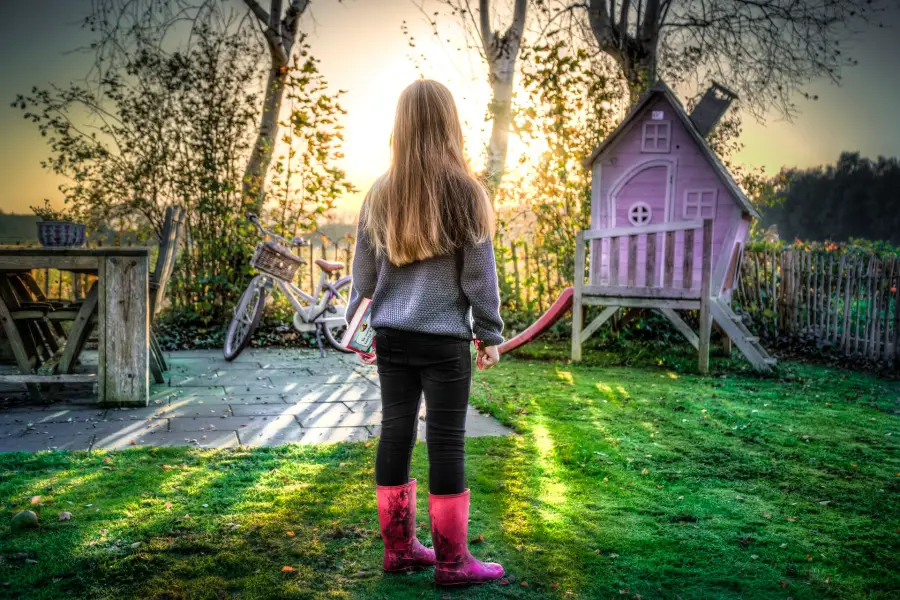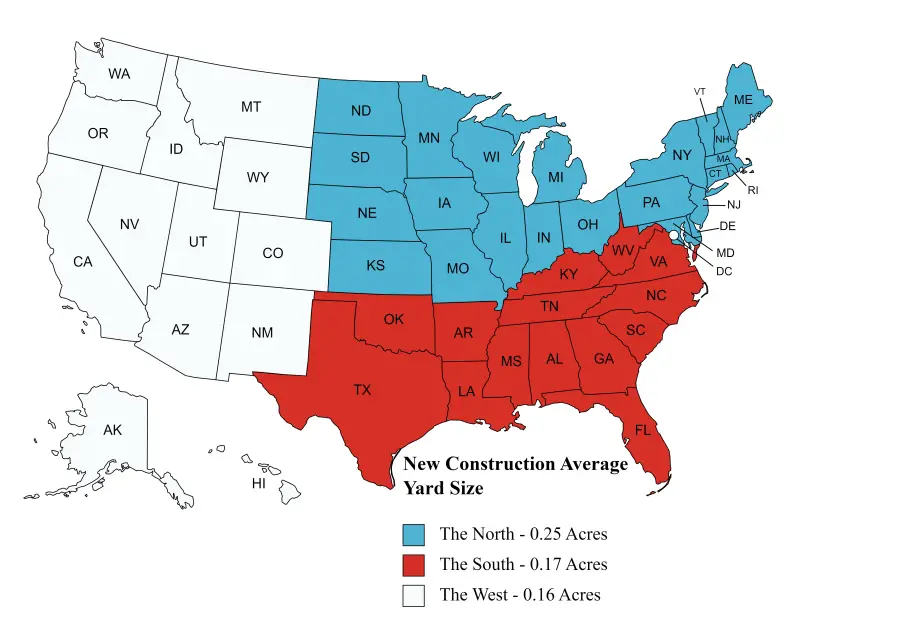Square footage is a common talking point whenever land is being discussed, so you must be able to conceptualize what certain values mean. In the case of houses and yards, square footage values are often in the thousands. As such, we’ve decided to make things simple by discussing what one thousand square feet represents.
A 1000 square foot yard is small in comparison with the average lawn size in every part of the United States. Even closer to urban centers this size of a yard is considered small. Normally a 1000 square foot yard will be found in condominiums or townhouses if they offer outdoor space.
The following article discusses how big 1,000-square foot homes and yards are in relation to averages. We will also talk about lawns of that size and what it takes to maintain them.
Let’s begin.

Contents
Is 1000 Square Feet Small For A Lawn?
When discussing space or land area, we have to contextualize with averages for similar properties or land use zones.
A 1000 square foot yard is tiny in comparison to U.S. national lawn size averages and small pitted against both suburban and urban spaces. In rural areas, yards can dwarf a 1000 square foot space with lawns normally being measured in terms of acres rather than square feet.
In the case of property lot sizes (area of the house plus area of outdoor space), buildings, and yards, the easiest comparison is with national averages. However, you must note that lot sizes vary extremely across the U.S., so you might also want to make comparisons with your local or neighborhood averages as well.
Property sizes are almost always inversely proportional to population density. This means that the greater the population density, the scarcer the land is. This makes land more valuable, which restricts the amount of land one can own.
The lower the population density, the more land is available. Greater availability makes land cheaper, meaning that people can have larger properties.
While population density is not the only influence behind property sizing, it is influential enough to a general rule. Generally, properties in the cities are smaller than suburban properties, which are in turn smaller than rural properties.
That said, 1,000 square feet (aka 32 by 32 feet) is small by most standards. Don’t forget, we’re talking about lot size here. The yard size of a 1,000 square-foot lot would be even less than that.
The average family home lot in the United States has an area of roughly 8,500 square feet. This average has actually dropped from 10,000 square feet just 30 years ago, further proving the population density correlation.
Residential suburban lots are between 2,500 and 5,000 square feet on (national) average. Rural lots have an average range of 7,500 and 15,000 square feet.
Yard Size In New Construction

Recent research states that even though in some parts of the United States lawn sizes have reduced in size slightly, it is in the Western and the Southern regions that the most shrinking has occurred in new construction.
As we discuss the relation of a 1000 sq ft lawn to others around the U.S., even in newer construction where lawns are considerably smaller each year we can see its relative tiny status.
Average yard sizes for new construction:
| U.S. Region | Average Lawn Size 1992 | Current Average Lawn Size |
| North | 0.22 acres / 9583 sq ft | 0.25 acres / 10890 sq ft |
| South | 0.22 acres / 9583 sq ft | 0.17 acres / 7405 sq ft |
| West | 0.22 acres / 9583 sq ft | 0.16 acres / 6970 sq ft |
Of course, these averages are brought down considerably by subdivision and urban environments. The size of many lawns in the rest of these regions will be well over these numbers.
1000 Square Foot Yard Size Comparison
Interestingly, 1,000 square feet is a bigger space than an average 2-bedroom apartment in New York City. These usually top out at 900 square feet! Of course, most apartments don’t have backyards. Some townhouses might have small yards though.
Apartments aside, 1,000 square feet is lower than most residential property averages by state. Even California, the state with the highest land demand, has an average residential lot size of about 1,700 sq ft.
In states with the highest average lot sizes, 1,000 sq ft is a relative speck. States like Vermont and Montana have titanic properties, with averages well beyond 70,000 sq ft.
So, at best, 1000 sq ft is pretty small. At worst, it’s tiny.
Here are some other articles you will enjoy…
- Acreage Mowing: How Long Does It Take And What Is The Cost?
- To Bush Hog Acres: How Much And How Long?
- How Long To Mow An Acre And What Mower Size Is Best?
How big is a 1000-square foot lawn?
As you can now see by comparing a 1000 square foot yard to others in the U.S., it is not very big. In fact, it is very small when you consider that the average U.S. backyard covers a space of about 6,000 sq ft.
A small 1000 square foot sized lawn would be about 32 by 32 feet of grass. An average 6 foot tall man has a stride of around 3 feet in length. This means that it would only take him approximately 10 steps to walk from one side of the lawn to the other.
Such a lawn would be most suitable for a couple or a very young family with a toddler and a small pet. It can also host small functions like barbeques and brunches.
It is less suitable for larger families with elementary school-age kids and large dogs who love running around. Yard space is less of a requirement for kids these days because of extracurricular school activities. However, pets like dogs need enough space to play and exercise adequately, especially if owners are too busy for walks.
As well, dogs use the lawn as a place to deposit their… well, waste. Smaller yards offer less choice in where they plan to do their business. Urine and feces in a large area will be spread out. This cuts down on the smell, acidic build up from urine, and foot or paw traffic. Smaller yards simply take a beating from pets like our canine friends.
You will also have to look for a bigger venue if you’re planning on hosting larger functions or keeping free-range livestock. That may sound crazy, but when I lived in Los Angeles I saw so many backyard chickens on tiny plots that it became commonplace. Needless to say, the already struggling grass usually struggled to survive.
How To Mow A Tiny Lawn
A key part of maintaining lawns, big and small, is mowing.
Mowing a small yard is hardly any different from mowing any other yard, except maybe quicker. Other differences are the size of the equipment used, the order in which things are done, and what is done with grass clippings. With beds and walks closer, bagging is preferable.
For starters, we recommend that you edge first. Clipping your overreaching runners and climbers first is a practical move on a small yard because bagging clippings is simple.
If your mower has a bagger, it makes more sense to edge and blow the clippings into the lawn before mowing. In this case, you bag all the clippings at once, unlike mowing first, edging, and then mowing again to collect edge clippings.
Tiny Lawns And Sunlight
Lawns in small yards are also vulnerable to the effects of lack of sunlight. Large lawns can supplement shaded areas much more effectively.
As such, you must adjust your mowing height in accordance with the amount of sunlight your grass receives. If you get clear sunshine all day, you can be free to cut the grass as short as you’d like.
However, grass in the shade needs every sliver of sun it can get for photosynthesis. Unless you prune or remove sources of shade, you will have to leave your grass longer, which means more frequent mowing.
Best Mowers For Tiny Yards
Now, let’s look at some of the best mowers for small yards.
We start with an American classic, the 1204-14 Reel Mower from the American Lawn Mower Company.
This mower is simple and effective and is perhaps the best entry lawnmower on the market. It boasts 4 reel blades with a 14-inch cutting width, as well as all-terrain polymer wheels and adjustable cutting height. From the solid handle grips to the alloy steel frame, the build quality is classic U.S.A.
The mower is capable of cutting grass up to 4 inches tall with minimal fuss. If you don’t want to contribute to noise and air pollution in your neighborhood, this mower is definitely one to think about.
The 1204 is also available with a grass catcher and a sharpening kit for even more convenience. You can get your hands on one for under US$100 from Amazon.
If your yard has a steep gradient, reel or push mowers might be too much of a physical strain. In such a scenario, you might be better off getting a self-propelled walk-behind mower.
Few machines in this category are better than the Honda HRS216VKA.
This mower is everything a modern self-propelled mower should be. Stylish, efficient, durable, and boasts a series of impressive innovations.
The HRS216VKA features a 16-gauge steel deck with a 21-inch cutting width. The deck height can be adjusted from 1 1/8 inches up to 4 inches, with six increments in between. Blade engagement and disengagement are managed via the blade control lever next to the handle.
At the heart of the HRS216VKA’s power is Honda’s classic GCV160 OHC motor. The engine churns out 5.5 horses which, when combined with the mower’s variable speed belt clutch, results in speeds of up to 4 miles per hour.
Honda’s variable speed controller is highly intuitive and can be set to your precise walking pace so you never feel like you’re chasing after the machine.
The HRS216’s self-propulsion system makes it powerful enough to work on slopes. Just a word of safety…always wear protective footwear when mowing slopes.
The mower has a retail price of around $500, depending on options. You also get a 3-year residential use warranty.
The Final Touches On A 1000 Square Foot Yard…
Is a 1000 square foot lawn small? You bet it is.
It is 1/6 the size of lawns in new construction today. New construction tends to always decrease the size of the lawn in order to fit more homes on the same amount of land.
This tells you that if you are looking at a 1000 square foot lawn, you are considering a tiny yard.
To see more great articles from LawncareGrandpa.com…
- How Long To Mow An Acre And What Mower Size Is Best?
- Lawn Mower Gas Tank Size: 5 Most Popular Brands
- What Is Midiron Grass Seed? (Answered)
References
https://backyardbooster.com/backyard-size/
https://www.nyrentownsell.com/blog/what-is-a-common-size-for-a-two-bedroom-in-new-york-city/
https://powerequipment.honda.com/lawn-mowers/models/hrs216vka
